
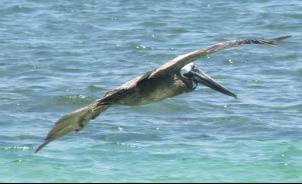 The Brown Pelican is a very large, stocky bird with a dark brown body and a long
flat bill. It is the only non-white pelican in the world. The brown pelican has a
very long gray bill with a large pouch of skin. Its pouch holds two or three times
more than its stomach can hold ó close to three gallons of fish and water! Males
and females look the same.
The Brown Pelican is a very large, stocky bird with a dark brown body and a long
flat bill. It is the only non-white pelican in the world. The brown pelican has a
very long gray bill with a large pouch of skin. Its pouch holds two or three times
more than its stomach can hold ó close to three gallons of fish and water! Males
and females look the same.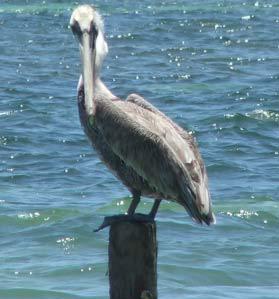 The brown pelican can be found on the Atlantic,
Pacific and Gulf Coasts.
The brown pelican can be found on the Atlantic,
Pacific and Gulf Coasts.
On the Atlantic Coast, it can be found from North Carolina
south to Venezuela. On the Pacific Coast, its range stretches from Southern
California to Chile. After nesting season, it can be found as far north as British
Columbia and Nova Scotia. Although they are common in the coastal areas of
Belize, the Brown Pelican is listed as an Endangered Species in the US.
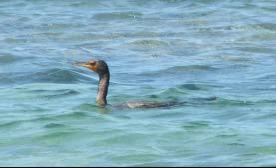
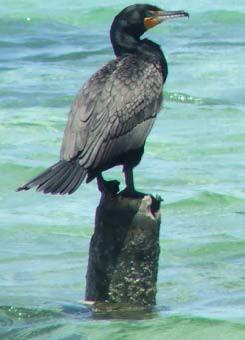 The Double-crested Cormorant is a solidly built black bird with an orange throat
pouch and long neck. This bird is an excellent diver and its long hooked bill is tilted
upward when the bird swims. Double-crested Cormorant nests often are exposed
to direct sun, and the dedicated parents shade the chicks and also bring them
water, pouring it from their mouths into those of the chicks. The Double-crested
Cormorant is the most numerous and widespread North American cormorant. Itís
also the only one that occurs in large numbers inland as well as on the coast.
The Double-crested Cormorant is a solidly built black bird with an orange throat
pouch and long neck. This bird is an excellent diver and its long hooked bill is tilted
upward when the bird swims. Double-crested Cormorant nests often are exposed
to direct sun, and the dedicated parents shade the chicks and also bring them
water, pouring it from their mouths into those of the chicks. The Double-crested
Cormorant is the most numerous and widespread North American cormorant. Itís
also the only one that occurs in large numbers inland as well as on the coast.
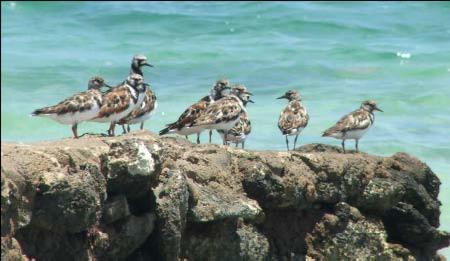
Shorebirds, which include Sandpipers,
Plovers and Stilts, are tough to identify.
Ambergris has the Black-necked
Stilt, about six species of plovers and
possibly twenty species of sandpipers.
Most shorebirds are small, like a sparrow
or a medium-sized robin, with slender
bills for probing in the mud or sand,
and slender legs for wading. Hundreds
of different patterns on these birds make
it almost impossible to identify them.
Donít be discouraged, just try to answer,
is it a sandpiper or plover? Plovers
are generally smaller than sandpipers
with shorter, thicker bills and
have a behavior of run and stop, run
and stop, looking for food in the wave
action on the beach.

 A long-winged, fork-tailed bird of tropical oceans, the Magnificent Frigatebird
is an agile flier that snatches food off the surface of the ocean and steals food
from other birds. It breeds mostly south of the United States, but wanders northward
along the coasts during nonbreeding season. Also called man-oí-war-birds,
they have the largest wingspread in proportion to weight of any bird. The male is
entirely black with a red throat pouch. The black female is larger and has a white
chest. Although the Magnificent Frigatebird spends most of its life flying over the
ocean, it rarely, if ever lands on the water.
A long-winged, fork-tailed bird of tropical oceans, the Magnificent Frigatebird
is an agile flier that snatches food off the surface of the ocean and steals food
from other birds. It breeds mostly south of the United States, but wanders northward
along the coasts during nonbreeding season. Also called man-oí-war-birds,
they have the largest wingspread in proportion to weight of any bird. The male is
entirely black with a red throat pouch. The black female is larger and has a white
chest. Although the Magnificent Frigatebird spends most of its life flying over the
ocean, it rarely, if ever lands on the water.
Click here to return to the main page for Caribbean Critters


 The Brown Pelican is a very large, stocky bird with a dark brown body and a long
flat bill. It is the only non-white pelican in the world. The brown pelican has a
very long gray bill with a large pouch of skin. Its pouch holds two or three times
more than its stomach can hold ó close to three gallons of fish and water! Males
and females look the same.
The Brown Pelican is a very large, stocky bird with a dark brown body and a long
flat bill. It is the only non-white pelican in the world. The brown pelican has a
very long gray bill with a large pouch of skin. Its pouch holds two or three times
more than its stomach can hold ó close to three gallons of fish and water! Males
and females look the same. The brown pelican can be found on the Atlantic,
Pacific and Gulf Coasts.
The brown pelican can be found on the Atlantic,
Pacific and Gulf Coasts. 
 The Double-crested Cormorant is a solidly built black bird with an orange throat
pouch and long neck. This bird is an excellent diver and its long hooked bill is tilted
upward when the bird swims. Double-crested Cormorant nests often are exposed
to direct sun, and the dedicated parents shade the chicks and also bring them
water, pouring it from their mouths into those of the chicks. The Double-crested
Cormorant is the most numerous and widespread North American cormorant. Itís
also the only one that occurs in large numbers inland as well as on the coast.
The Double-crested Cormorant is a solidly built black bird with an orange throat
pouch and long neck. This bird is an excellent diver and its long hooked bill is tilted
upward when the bird swims. Double-crested Cormorant nests often are exposed
to direct sun, and the dedicated parents shade the chicks and also bring them
water, pouring it from their mouths into those of the chicks. The Double-crested
Cormorant is the most numerous and widespread North American cormorant. Itís
also the only one that occurs in large numbers inland as well as on the coast.


 A long-winged, fork-tailed bird of tropical oceans, the Magnificent Frigatebird
is an agile flier that snatches food off the surface of the ocean and steals food
from other birds. It breeds mostly south of the United States, but wanders northward
along the coasts during nonbreeding season. Also called man-oí-war-birds,
they have the largest wingspread in proportion to weight of any bird. The male is
entirely black with a red throat pouch. The black female is larger and has a white
chest. Although the Magnificent Frigatebird spends most of its life flying over the
ocean, it rarely, if ever lands on the water.
A long-winged, fork-tailed bird of tropical oceans, the Magnificent Frigatebird
is an agile flier that snatches food off the surface of the ocean and steals food
from other birds. It breeds mostly south of the United States, but wanders northward
along the coasts during nonbreeding season. Also called man-oí-war-birds,
they have the largest wingspread in proportion to weight of any bird. The male is
entirely black with a red throat pouch. The black female is larger and has a white
chest. Although the Magnificent Frigatebird spends most of its life flying over the
ocean, it rarely, if ever lands on the water.
